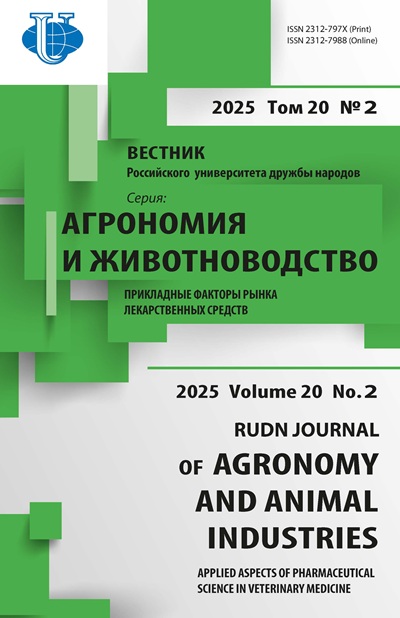Productivity of soybean varieties under different irrigation regimes
- Authors: Tolokonnikov V.V.1, Kancer G.P.1, Koshkarova T.S.2, Chamurliev G.O.3
-
Affiliations:
- Russian Research Institute of Irrigated Agriculture
- V.S. Pustovoit Russian Research Institute of Oil Crops
- Peoples’ Friendship University of Russia (RUDN University)
- Issue: Vol 15, No 4 (2020)
- Pages: 343-352
- Section: Crop production
- URL: https://agrojournal.rudn.ru/agronomy/article/view/19602
- DOI: https://doi.org/10.22363/2312-797X-2020-15-4-343-352
- ID: 19602
Cite item
Full Text
Abstract
Abstract. World soybean acreage increases by 3 million hectares annually with average yield of 2.7 t/ha. Significant growth of soybean production in Russia is constrained by increased climate aridization and a declining yield of up to 1.5 t/ha. An important factor in intensification of soybean production is to expand its crops under irrigation. Introduction of adapted and high-yielding varieties of regional selection, followed by improvement of crop water supply, increases yields up to 3…4 t/ha. Soybean varieties selected by Russian Research Institute of Irrigated Agriculture and admitted to production in the Lower Volga region: VNIIOZ 86 (since 2002), VNIIOZ 31 (since 2011), Volgogradka 2 (since 2020) were studied. The experiments were conducted at Russian Research Institute of Irrigated Agriculture in 2013-2015. The experiment included two factors: factor A - varieties, factor B - irrigation regime (70-80-70 % of FMC, 80-80-70 % of FMC and control - 80-80-80 % of FMC). Plots of the 1st (600 m2) and 2nd (200 m2) order were sown in 4-fold replication by a wide-row method (0.7 m) in mid-May with a planned yield of 2.5…3.5 t/ha (N90P90K60 a. i./ha). Soybean varieties differed in peculiarities of crop structure formation. Differentiated irrigation regime resulted in more cost-efficient water consumption followed by yield increase compared to the control. The highest yields were formed by Volgogradka 2 variety (2.87…3.23 t/ha) and VNIIOZ 31 (2.82…3.19 t/ha), which was significantly higher than in VNIIOZ 86 variety (2.17…2.51 t/ha). The variable irrigation regime led to yield increase in all soybean varieties, especially in Volgogradka 2 - by 0.31…0.36 t/ha (10.8…12.5 %) as compared to the control. It was due to grain increase to 30.9…36.2 % in the total biomass compared to the control values - 26.6…27.5 %. The highest amount of post-harvest plant residues (stems, leaves and roots) remained after harvesting Volgogradka 2 (6.39…7.63 t/ha) and VNIIOZ 31(6.73…7.9 t/ha), which improved soil fertility well, and the smallest amount was after VNIIOZ 86 variety (4.41…5.66 t/ha). Differentiated irrigation regime led to decrease in vegetative mass in soil - 4.41…7.42 t/ha compared to the control (5.66…7.9 t/ha). Thus, Volgogradka 2 and VNIIOZ 31 can be recommended for irrigated agriculture in the Lower Volga region, as they provide high yields under differentiated (relatively cost-efficient) irrigation regime and improve soil fertility due to large biomass remained in soil after harvesting.
About the authors
Vladimir V. Tolokonnikov
Russian Research Institute of Irrigated Agriculture
Author for correspondence.
Email: tolokonnikov@vniioz.ru
Doctor of Agricultural Sciences, Leading Researcher, Department of Intensive Technologies for Crop Cultivation
9 Timiryazeva st., Volgograd, 400002, Russian FederationGalina P. Kancer
Russian Research Institute of Irrigated Agriculture
Email: vniioz@yandex.ru
Researcher, Department of Intensive Technologies for Crop Cultivation
9 Timiryazeva st., Volgograd, 400002, Russian FederationTatyana S. Koshkarova
V.S. Pustovoit Russian Research Institute of Oil Crops
Email: koshkarova_ts@vniioz.ru
Candidate of Agricultural Sciences, Senior Researcher, Soy Department
17 Filatova st., Krasnodar, 350038, Russian FederationGeorgy O. Chamurliev
Peoples’ Friendship University of Russia (RUDN University)
Email: giorgostsamourlidis@mail.ru
Candidate of Agricultural Sciences, Senior Lecturer, Agrarian and Technological Institute
6 Miklukho-Maklaya st., Moscow, 117198, Russian FederationReferences
- Gossortommission. State register of selection achievements approved for use in 2018. Available from: http://reestr.gossort.com [Accessed: 3rd December 2019].
- Slobodyanik NS. Breeding new varieties of soybean in the production process of original seeds. International Research Journal. 2015; 1 (32) P. 1: 104—105. (In Russ).
- Kruzhilin IP. Optimizatsiya vodnogo rezhima pochvy dlya polucheniya zaplanirovan-nykh urozhaev sel’skokhozyaistvennykh kul’tur v stepnoi zone i polupustynnoi zonakh Nizhnego Povolzh’ya [Optimization of the water regime of the soil for obtaining planned crop yields in the steppe zone and semi-desert zones of the Lower Volga region] [Dissertation] Volgograd; 1982. (In Russ).
- Tedeeva AA, Khokhoeva NT, Tedeeva VV. Advanced elements of technology for leguminous crops cultivation. Advances in current natural sciences. 2018. (7):59—64. (In Russ).
- Vital RG, Muller S, Da Silva FB, Batista PF, Merchant A, Fuentes D, et al. Nitric oxide increases the physiological and biochemical stability of soybean plants at high temperature. Agronomy. 2019; 9(8):412. doi: 10.3390/agronomy9080412
- Koshkarova TS, Tolokonnikov VV, Kantser GP, Mukhametkhanova SS. Modernization of seed production methods for soybean varieties in the Lower Volga region. Proceedings of Nizhnevolzskiy agrouniversity complex: science and higher vocational education. 2020; (3):205—211. (In Russ). doi: 10.32786/2071–9485–2020–03–21.
- Miladinović J, Ćeran M, Đorđević V, Balešević-Tubić S, Petrović K, Đukić V, et al. Allelic variation and distribution of the major maturity genes in different soybean collections. Frontiers of Plant Science. 2018; 9:1286. doi: 10.3389/fpls.2018.01286
- Food and Agriculture Organization of the United Nations. Statistics Vision, 2016. Available from: http://faostat3.Fao.org/download9/gs/e [Accessed: 3rd December 2019].
- Tolokonnikov VV, Kancer GP, Koshkarova TS, Kozhukhov IV. Adaptive, high-white soybean grades for cultivation in meliorized agrolandscapes in south and central Russia. Proceedings of Nizhnevolzskiy agrouniversity complex: science and higher vocational education. 2018; (4):166—170. (In Russ). doi: 10.32786/2071–9485– 2018–04–23
- Chamurliev OG, Tolokonnikov VV. Influence of varietal characteristics and techniques of AG-rostehnika on soybean yields under irrigation. Proceedings of Nizhnevolzskiy agrouniversity complex: science and higher vocational education. 2015; (3):87—91. (In Russ).
- Robison JD, Yamasaki Y, Randall SK. The ethylene signaling pathway negatively impacts CBF/DREB-regulated cold response in soybean (Glycine max). Frontiers in Plant Science. 2019; 10:121. doi: 10.3389/ fpls.2019.00121
Supplementary files















